The Corsair CS450M PSU Review
by E. Fylladitakis on June 10, 2015 8:00 AM EST- Posted in
- PSUs
- Corsair
- Cases/Cooling/PSUs
- 80Plus Gold
External Appearance
When you are on a tight budget, aesthetics are of secondary importance, but they are rarely ever of no importance at all. Corsair realizes that and they kept the appearance of the CS450M relatively plain but aesthetically subtle. Perhaps even overly subtle, as almost everything on the CS450M is black. The steel chassis has been sprayed with a matte black paint, a standard round black finger guard stands above the black cooling fan and the cables are entirely black as well. Only the side stickers with the company and series logo intrude on the blackness of the CS450M.
Other than that, the CS450M is built inside a standard, ATX-compliant 140 mm steel chassis. A sticker with the electrical and safety specifications of the PSU can be seen at the top side of the chassis. There is virtually nothing of real importance at the rear of the chassis, only a basic on/off switch and an AC power cable receptacle. Four cable connectors for the modular cables can be found at the front of the chassis.
Internal Design
Yate Loon supplies the black 120 mm fan responsible for the cooling of the CS450M. It is a rather basic model, with a sleeve bearing engine and a maximum speed of 1,650 RPM. Considering the small power output and efficiency of the CS450M, this fan should never go anywhere near its maximum speed to maintain low operating temperatures.
Corsair entrusted the CS450M to Great Wall, a Chinese OEM that we are not very accustomed to seeing. As a matter of fact, no other PSU that we have ever seen uses this particular platform, so either Corsair designed it themselves and Great Wall is just building the PSUs, or Great Wall is allowing Corsair to use it exclusively. It does not matter either way, as the quality and performance of the PSU are what actually matters to the consumer. As far as quality is concerned, CS450M is substantially better than we initially anticipated considering the retail price of the PSU.
The filtering stage is textbook, with four Y capacitors, two X capacitors and two filtering inductors. One of the X capacitors, the one at the back of the AC receptacle, is a little oddly placed, with wires connecting it to the PCB and the body of the capacitor glued on the back of the PCB itself. An effective but very crude solution to the space problem. A NTC thermistor blocks large inrush currents and a simple relay short-circuits it once its job is done. The primary capacitor of this particular unit is relatively small and the inrush current should not reach noteworthy value, but Corsair is using the same platform for many other products, including models nearly twice as powerful, with much higher capacitance.
The primary side heatsink holds the main rectifying bridge, the active PFC components and the primary inversion transistors. The PFC inductor is a sealed type, meaning that the naked large inductor has been replaced by a black plastic block. Theoretically, this could suppress the generation of "coil-whine" noise problems, as that high frequency sound originates from the high frequency vibrations of the inductors under electromechanical stress. Surprisingly, the primary PFC capacitor is supplied by Rubycon and is rated at 400V/390μF. Rubycon is one of the most reputable capacitor manufacturers and we rarely see their products used outside premium products, so finding one in the CM450M is, mildly put, unexpected.
Meanwhile the secondary conversion transistors generate the 12V line, while the 3.3V/5V lines are being derived from it using DC-to-DC conversion circuits. A small transformer is present for the generation of the 5VSB line as well. The secondary capacitors are a very complex mixture of electrolytic and polymer capacitors alike. The electrolytic capacitors are supplied by Nippon Chemi-Con, Teapo and CapXon, while the polymer capacitors are a mix of Teapo and Chinsan products.


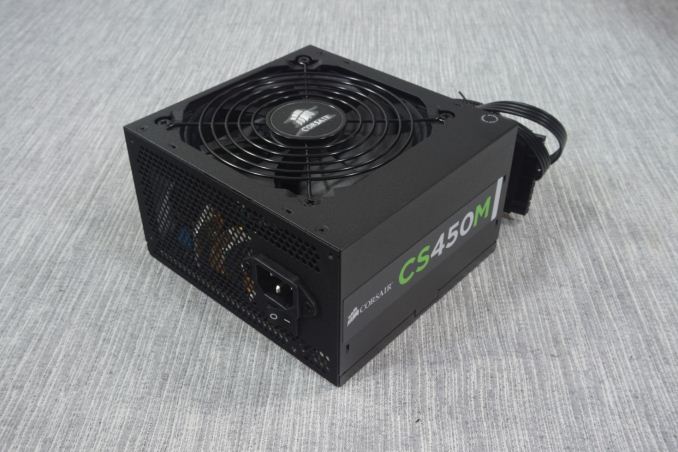





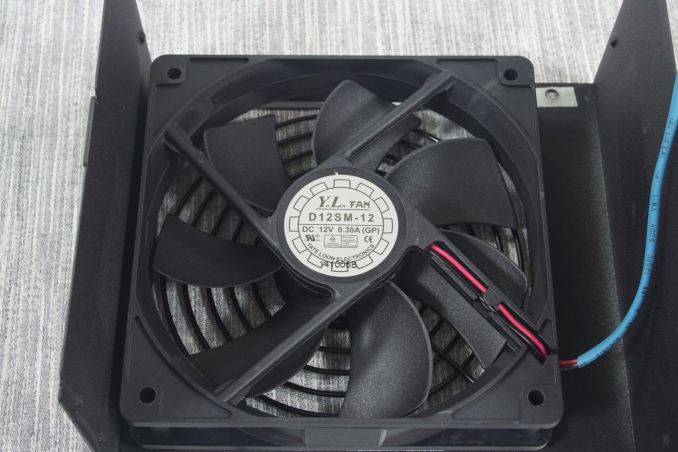
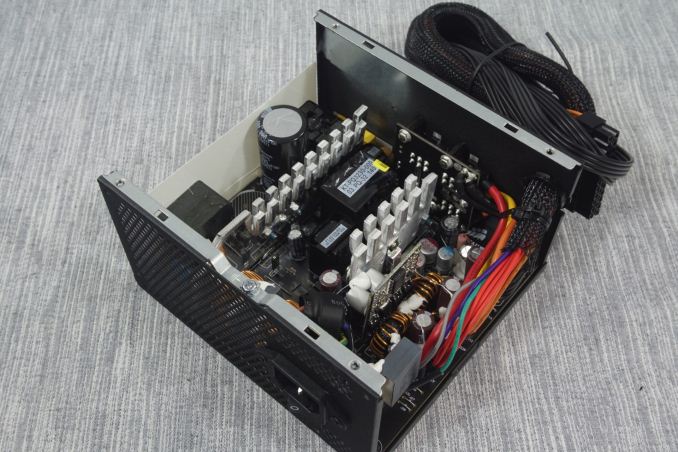
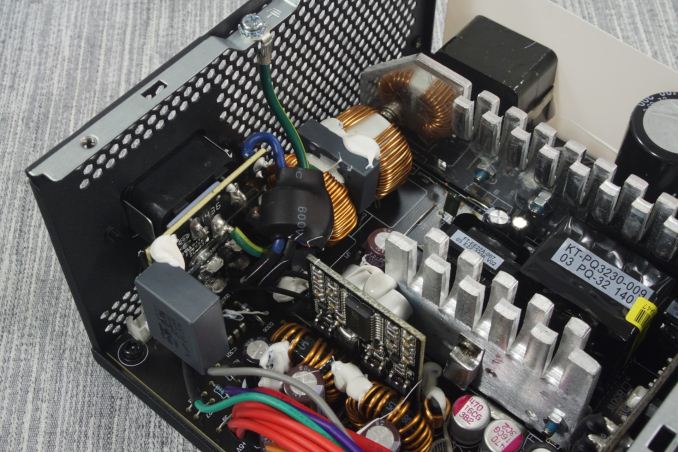
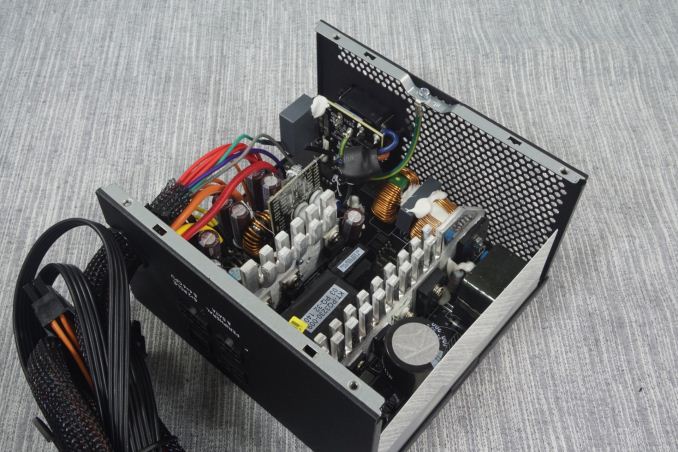
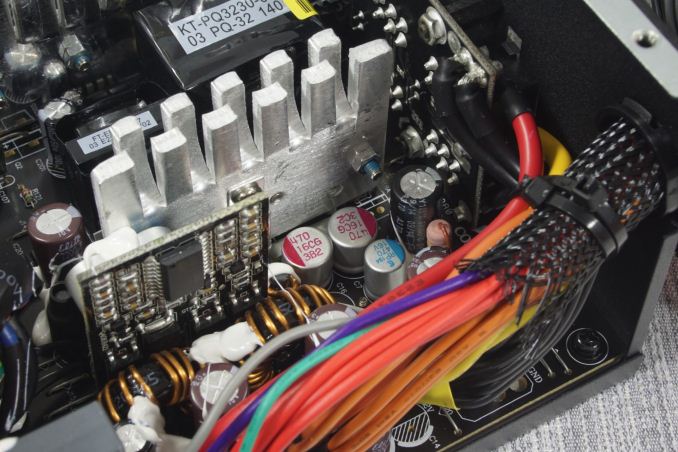








46 Comments
View All Comments
Shadow7037932 - Thursday, June 11, 2015 - link
" Even those of secondary importance are supplied by known manufacturers and are rated for operation at 105°C, a figure that it is next to impossible to be reached inside a 450W unit as efficient as this one. "This isn't entirely accurate. The ambient temps around the caps especially the ones near the bridge rectifiers can be significantly higher than your average ambient temp of 25C. Sure, they won't really hit 105C ambient but temperature has a significant impact on the performance of electrolytic capacitors.
TurboTastic - Thursday, June 11, 2015 - link
I know there's already a huge number of comments saying this, but as someone who clamored for sane-wattage PSU reviews, I want to add my voice to the chorus saying "Thank you for listening to the readers and reviewing a <500W PSU!" I will definitely be considering this PSU in future builds - we need a new HTPC in the living room, and this might be a perfect fit!Seasonic's SSR-450RM is also in the running. It looks like it does have a few more cable options, including the 2x PCIe 8/6 pin power cables, but I'm not sure if it has the efficient rectification or quiet operation demonstrated in this review.
Seasonic - if someone is listening, thinks your product is better than Corsair's, and wants to make a (bunch of) sale(s), send an SSR-450RM to E. Fylladitakis!
Pissedoffyouth - Friday, June 12, 2015 - link
I love anandtech but PLEASE can you stop this graph crap. Start it at zero and end at 100, otherwise it makes the results seem different than they are.I expect more from this site.
ShieTar - Friday, June 12, 2015 - link
0 to 100 Watts? Degrees? Decibels? Efficiency? The graphs are perfectly fine as they are, why would anybody want to scale any single graph to 0 to 100 Units? Even on efficiency, scaling them to the proposed range would just make all graphs in all reviews look the same. Whats the point in that?FredAZ - Saturday, June 13, 2015 - link
When adding "age" to a word it means the rate at which something is attained. For Example "mileage" means the number of miles per gallon that a car attains. The term "watts" is the term for power, which already measures the flow of energy, or joules per second. Proper electrical terminology: power, current, Voltage, Energy, charge,wattage is redundant, please use "power", power already means the rate at which energy is being delivered, watts are the units
amperage is redundant, please use "current", current means the rate at which charge is being delivered, amperes (amps) are the units
voltage is proper because the correct term is elector-motive-force or emf, and no one understands this.
lagittaja - Sunday, June 14, 2015 - link
Great to see more reasonable power supply reviews from you.Now go and pester Super Flower, Seasonic and EVGA for review samples.
For example the Seasonic G-360, G-550. Super Flower Leadex or just EVGA's G2 lineup, the 550W G2 would be nice to see.